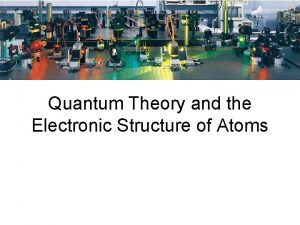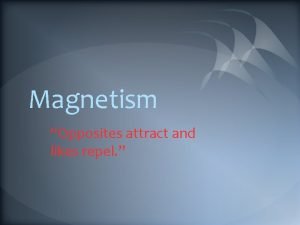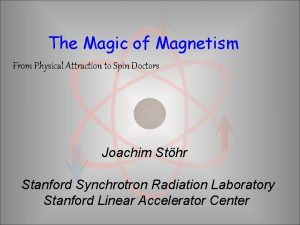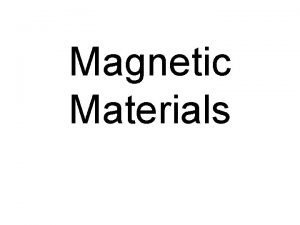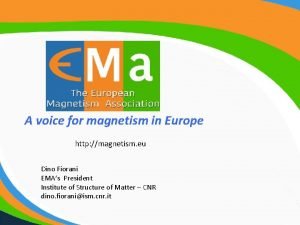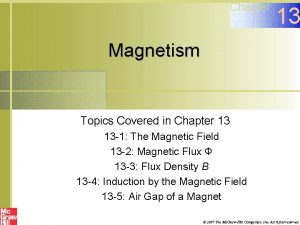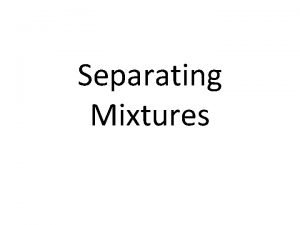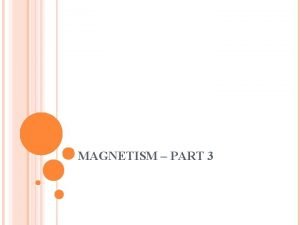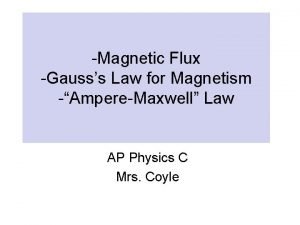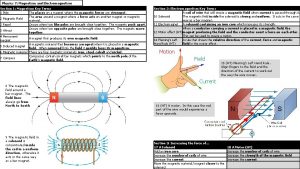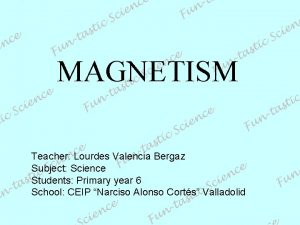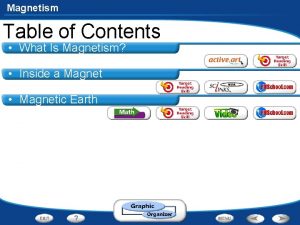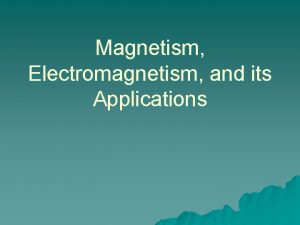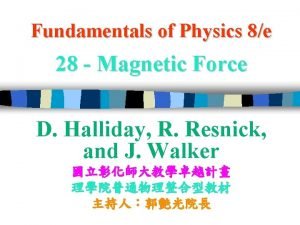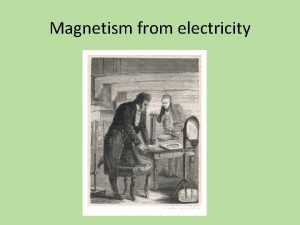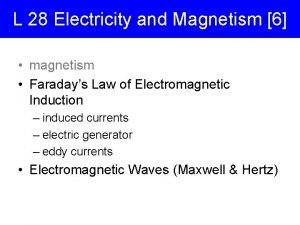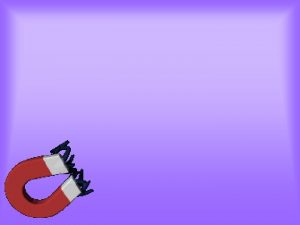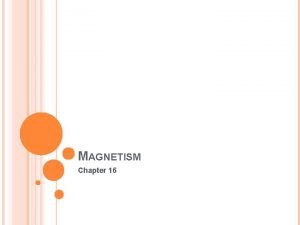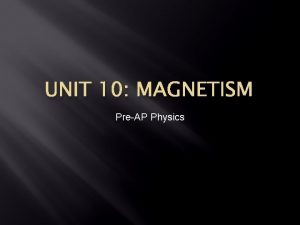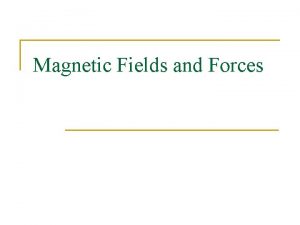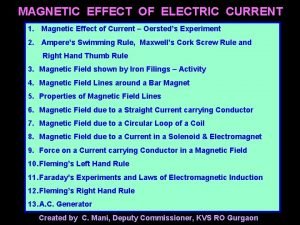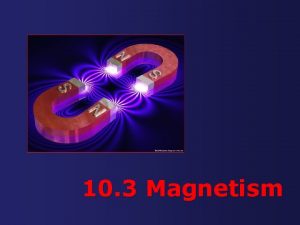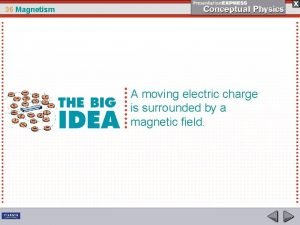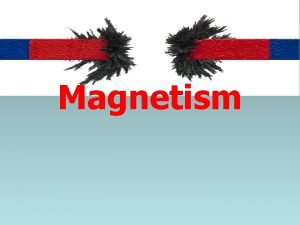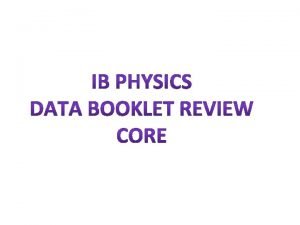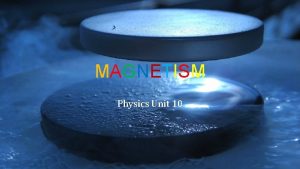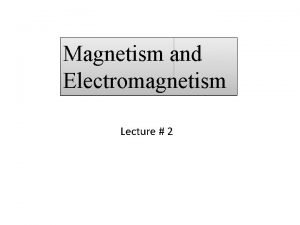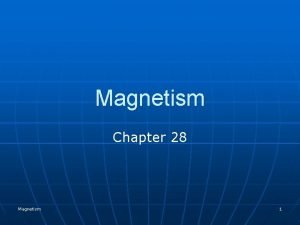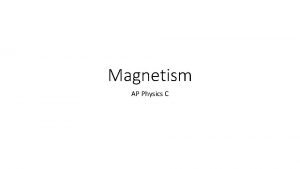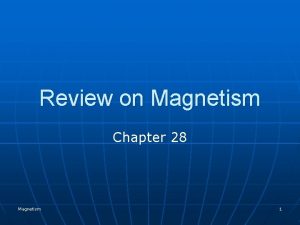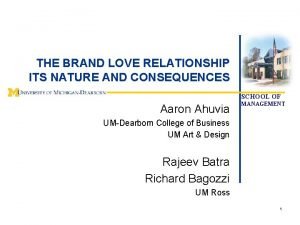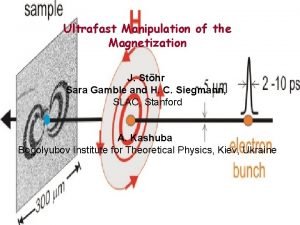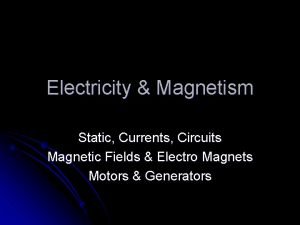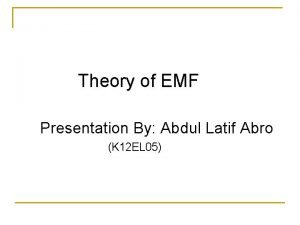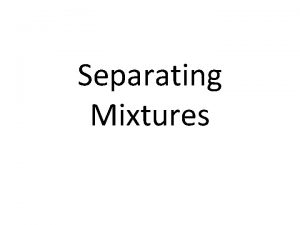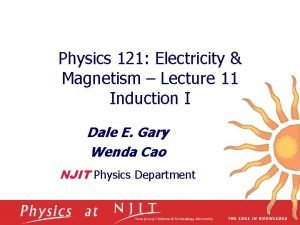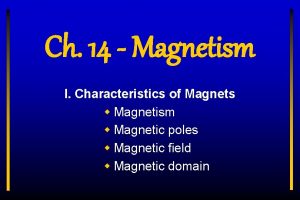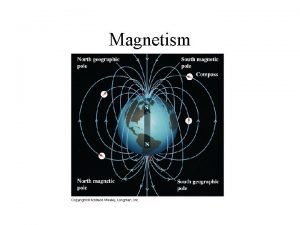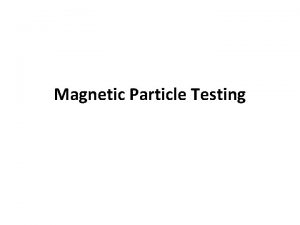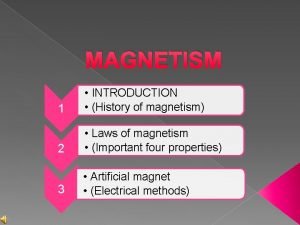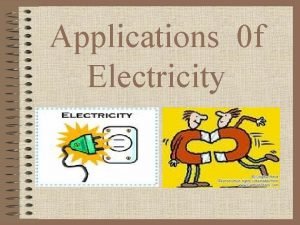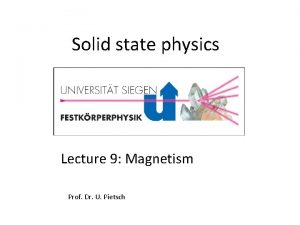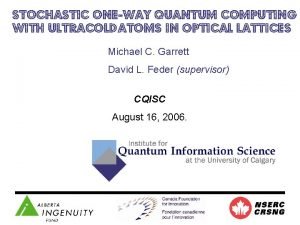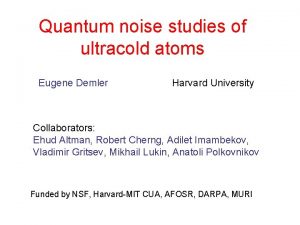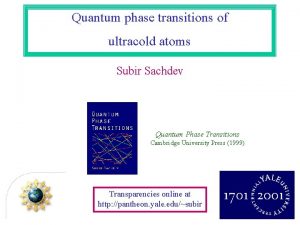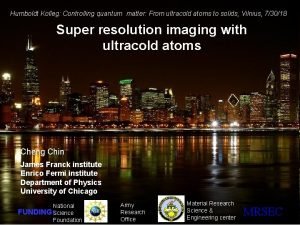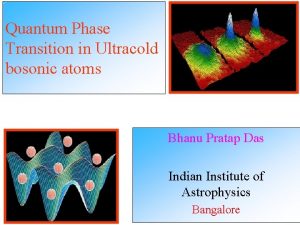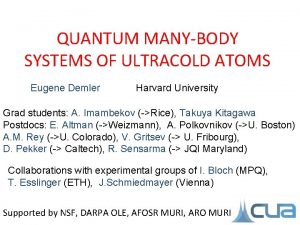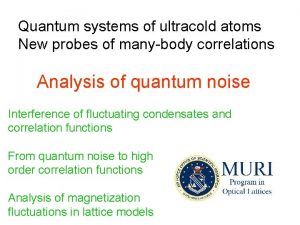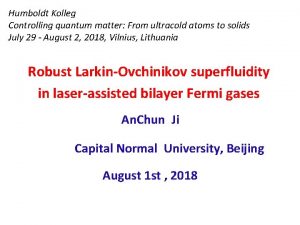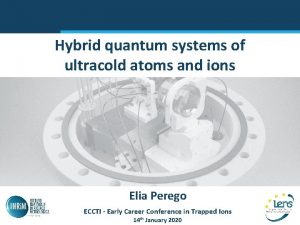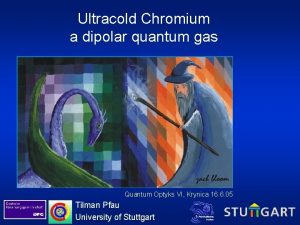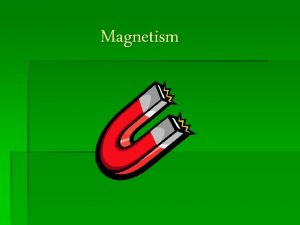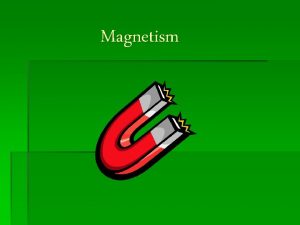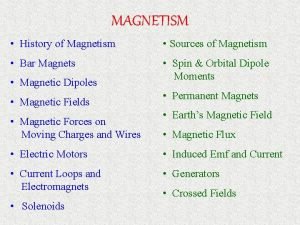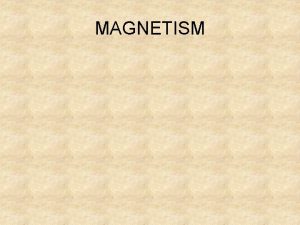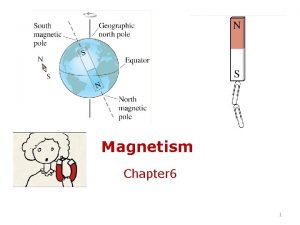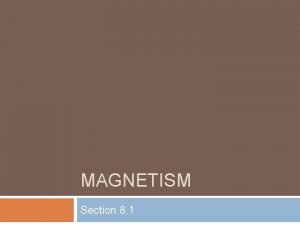Towards Quantum Magnetism with Ultracold Atoms Wolfgang Ketterle































































- Slides: 63

“Towards Quantum Magnetism with Ultracold Atoms” Wolfgang Ketterle Massachusetts Institute of Technology MIT-Harvard Center for Ultracold Atoms 11. Nov. 2010 EMMI Workshop GSI, Darmstadt

New Materials – driving force for modern technology • high temperature superconductors • carbon nanotubes • colossal magneto-resistance materials … However: Physical modeling of these new materials is currently impeded by our limited understanding of strongly interacting many-electron systems

Crystal structure of high-temperature superconductors

Superconductors and other modern materials still have many unresolved mysteries What is the simplest system to study superfluidity and magnetism? A dilute gas

ULTRA-dilute gases Ultralow density: 1013 cm-3 a million thinner than air Almost nothing 0. 01 femtomole But: Those atomic gases can be strongly interacting They can show strong correlations Like liquids Like solids Like superconductors Like a ferromagnet When cooled to nanokelvin temperatures

Why quantum simulators? New materials harnessing strong correlations in many-electron systems: Nanotubes, quantum magnets, superconductors, … Approximations, Quantum simulators: Controlled, “simple” systems Impurities, testing models and verifying concepts no exact solutions ? Condensed matter models: Simple models which capture the relevant mechanism

Analogy New airplanes ? Testing and understanding models: Wind tunnel Approximations Engineering design

Cold atoms: 25 years of laser cooling 14 years of degenerate quantum gases All focused on controlling and freezing out motion • Bose-Einstein condensation • Matter wave propagation • Superfluid Fermi gases • Superfluid-to-Mott insulator transition

Next challenge Magnetic ordering - quantum magnetism (ferromagnetism, antiferromagnetism, spin liquid, …) Dominant entropy: spin entropy

Two paradigms of magnetism • Magnetism of localized electrons • superexchange interactions • localized spin • Magnetism of itinerant electrons • delocalized conduction electrons • Stoner criterion • transition metals and their alloys Schematics for free electron gas *Other “exotic” form of magnetism in BECs: • Spinor BEC: Weak spin-dependent mean field, but with bosonic enhancement • Dipolar BEC


Itinerant Ferromagnetic Phase Transition in Ultracold gases Increasing k. Fa 22/3 EF EF Energy : Spin

Two fermions in a well Non-interacting Singlet Short range interaction Triplet Energy Singlet Interaction strength

Two known theorems: For arbitrary spin-independent interactions, the ground state is always a singlet state • For two particles • In 1 D (Lieb-Mattis theorem, 1962) No solution of proof so far for 2 D or 3 D. For three particles in HO: ground state can be ferromagnetic (Drummond, ICAP 2010)

Itinerant Ferromagnetism T=0 Mean-field Stoner model for the phase transition local magnetization K. E. spin up K. E. spin down repulsive mean field interaction

Itinerant Ferromagnetic Phase Transition T=0 Mean-field model • Constant Pressure (minimizing Enthalpy H) Onset of magnetization Minimum of kinetic energy Maximum in volume

Realize the Stoner model for itinerant ferromagnetism in a trapped two-component Fermi gas “Solve” the Hamiltonian by performing an experiment …. Does this Hamiltonian have a phase transition to a ferromagnetic state? or: is it possible to have a ferromagnetic gas (without lattice)? Theory: M. Houbiers et. al. (1997), M. Amoruso et. al. (2001), T. Sogo et. al. (2002), R. A. Duine et. al. (2005), I. Berdnikov et. al. (2008), S. Zhang et. al. (2008), L. Le. Blanc et. al. (2009), G. Conduit et al. (2009)

Feshbach Resonance Energy Atoms Molecules Magnetic field Molecules are unstable Atoms form stable molecules Atoms attract each other Atoms repel each other a<0 a>0 BEC of Molecules: Itinerant Ferromagnetism Condensation of Stoner instability tightly bound in a free gas fermion pairs BCS-limit: Condensation of long-range Cooper pairs

Preparation of an interacting Fermi 6 system in Li Typical parameters: Optical trapping: 10 W @ 1064 nm ω = 2π × (15, 0. 2) k. Hz Etrap = 1 m. K States |1> and |2> correspond to | > and | >


Experiments • Prepared a two-component Fermi gas( ~ 0. 65 million per each spin state) • Vary repulsive interactions near Feshbach resonance located at 834 G

Local Probe for magnetization n 1 n 2 Three body recombination rate (molecule formation) a 6 ntotal 2 (1 - 2) for small a, T T/Tf = 0. 55 T/Tf = 0. 22 T/Tf = 0. 12 Highly Suppressed Atom-Atom Collisions

Kinetic Energy of the gas At T/Tf = 0. 12 Minimum!

Three observations of non-monotonic behavior when approaching the Feshbach resonance • Suggests that itinerant FM can occur for a free gas with short-range interactions • First study of quantum magnetism in cold fermionic atoms • Quantum simulation of a Hamiltonian for which even the existence of a phase transition is unknown BUT: • Lifetime only 10 ms • Molecular fraction 25 % • Magnetic domains not resolved • Ferromagnetic fluctuations vs. ferromagnetic ground state G. B. Jo, Y. R. Lee, J. H. Choi, C. A. Christensen, H. Kim, J. Thywissen, D. E. Pritchard, W. K. , Science 325, 1521 -1524 (2009).

Mean field transition in the presence of the trapping potential Le. Blanc, Thywissen, Burkov & Paramekanti, Phys. Rev. A 80, 013607 (2009) Conduit & Simons, Phys. Rev. Lett. 103, 200403 (2009)

Domain growth after rapid quench across the phase transition Initial domains are VERY small Babadi, Pekker, Sensarma, Georges, Demler, ar. Xiv: 0908. 3483

Correlated versus Ferromagnetic State in Repulsively Interacting Two-Component Fermi Gases What is the equilibrium state? § Magnetic domains (i. e. ferromagnetic state) § Ferromagnetic fluctuations (correlations), i. e. non-magnetic state Hui Zhai, Physical Review A, 80, 051605 (2009) Jason Ho, private communication

Monte-Carlo simulations of hard core interactions and upper branch of Feshbach resonance Chang, Randeria & Trivedi, ar. Xiv: 1004. 2680 Pilati, Bertaina, Giorgini & Troyer ar. Xiv: 1004. 1169

Competition between pairing and ferromagnetic instabilities Pekker, Babadi, Sensarma, Zinner, Pollet, Zwierlein, Demler, ar. Xiv: 1005. 2366


Bosonic or fermionic Hubbard Hamiltonian is equivalent to spin Hamiltonian (for localized particles) Duan, Demler, Lukin (2003)

Magnetic Ground States Z-Ferromagnet: XY-Ferromagnet: Antiferromagnet:

Towards quantum magnetism • Characterization of new quantum phases density fluctuations to determine compressibility, spin susceptibility and temperature (MIT, ETH) • New cooling scheme spin gradient demagnetization cooling

Challenge: To reach the low temperatures (entropies) necessary for magnetic ordering Critical entropy for the Heisenberg antiferromagnet: S/Nk. B = ln 2/2

Fermions AF ordering requires T/TF 0. 02 … 0. 07 Bosons 3. 6 So far, entropies < log 2 have been reached, but not in a lattice (fermions) or with two component bosons

radial profiles of density and entropy

Ultracold atoms to do “room-temperature” physics Fermions: lowest T/TF achieved • for attractive interactions 0. 03 • for repulsive interactions 0. 1 Electrons in metal: typical TF is 30, 000 K room temperature is T/TF =0. 01 BUT: neutral atoms have adjustable interactions can be used to have high Tcrit e. g. s-wave superfluidity at T/TF = 0. 15 compared to 3 He (TF=0. 5 K): T/TF =0. 02 is 10 m. K

Rb lattice experiment @ MIT Towards quantum magnetism in a two-component Mott insulator

Goal: Magnetism of localized spins Requires TOTAL entropy to be less than N k. B log 2

Two component Bosons for Quantum Magnetism Before we can mix them, we have to control their separation Two component Mott insulator • equal mix of (2, -2) and (2, 2) states (or (1, -1)) • Variable B-field gradient • Polarization contrast imaging (or two absorption pictures): 2, +2 (or (1, -1) black, 2, -2 white 2, +2 2, -2 Mixture

Spin Gradient Thermometry in a 2 -component Mott insulator • Spins separate in a magnetic field gradient (1 G/cm typical) • At zero temperature: sharp boundary • At non-zero temperatures: finite boundary region

Spin Gradient Thermometry in the Mott Insulator Cold 52 n. K Hot 296 n. K D. M. Weld, P. Medley, H. Miyake, D. Hucul, D. E. Pritchard, W. K. , Phys. Rev. Lett. 103, 245301 (2009).

0. 7 G/cm 6 n. K 0. 06 G/cm 2 n. K 0. 0024 G/cm 0. 4 n. K Simulation Experiment Simulation includes buoyancy effect due to slightly different scattering lengths of the two states D. M. Weld, H. Miyake, P. Medley, D. E. Pritchard, W. K. ar. Xiv: 1008. 4610

Next: Use field gradient for manipulation Adiabatic change: adiabatic cooling of Mott insulator

Adiabatic demagnetization cooling a standard cryogenic technique Spin system (electron or nuclear spins) Equil. high B field Other degrees of freedom Tinitial Cool low B field Other degrees of freedom T<Tinitial

Negative temperatures Spin system (electron or nuclear spins) positive temperature high B field negative temperature fast inverted B field

Negative temperatures More energy than positive temperatures Possible only for systems with finite maximum energy higher energy 0 - T=0 absolute zero 0 T= equipopulation -1/T + T=-0 only highest energy state populated

Adiabatic demagnetization cooling a standard cryogenic technique Spin system (electron or nuclear spins) Needs spin flip collisions (Chromium (Pfau, 2006)) 50 p. K = 1 Hz = 0. 7 G Equil. high B field Other degrees of freedom Tinitial Cool low B field Other degrees of freedom T<Tinitial

Spin gradient demagnetization cooling high gradient, Tinitial Low gradient, T<<Tinitial No coupling with rest of system: width of the layer stays the same entropy Coupling with rest of system: Entropy flows into layer, larger width Principle of adiabatic cooling: Transform spin states into states with lower energy. Entropy of the system will flow to the spin states.

The Superfluid-Mott Insulator transition Shallow Lattices - Superfluid Deep Lattices – Mott Insulator

Mott insulator Optical lattice depth x slow spin relaxation Superfluid x Magnetic field gradient Demag. cooling

Positive and Negative Spin Temperatures closer to zero than 50 pico. Kelvin • Takes advantage of long relaxation times in Mott insulator

Negative temperatures More energy than positive temperatures Possible only for systems with finite maximum energy d. S=d. Q/T higher energy 0 - T=0 absolute zero entropy 0 T= equipopulation max. entropy -1/T + T=-0 only highest energy state populated zero entropy

Spin Heating

Note: Spin polarized atoms in magnetic traps have a state purity of typically 1 -10 -5 At 100 m. G bias field: Tspin= - 500 n. K p. K temperatures need G! Here: m. G/cm gradient, 10 m resolution

Mott insulator Optical lattice depth x Superfluid slow fast spin relaxation x Magnetic field gradient Demag. cooling

Simulation of entropy density: Demagnetization from 0. 5 to 0. 02 G/cm Temperature reduced from 3 to 0. 5 nk

Theory: simple model for entropy based on deep lattice, assuming perfect adiabaticity

Demagnetization Cooling 350 ± 50 pico. Kelvin

Lowest temperatures ever recorded Previous low temperature records § Kinetic temperature in a gas: 450 p. K, MIT (2003) § Spin temperature: 100 p. K, - 750 p. K Helsinki (2000, 1993)

Magnetic Ground States Z-Ferromagnet: XY-Ferromagnet: Antiferromagnet:

Use the tools and precision of atomic physics to realize new phenomena (Hamiltonians) of many-body physics Bosons • Weakly interacting Bose gas • Bose-Hubbard model (Mott insulator) • 1 D Tonks gas • 2 D KBT transition • Anderson localization of atoms Fermions • BEC-BCS crossover • Fermions with “infinite” interaction strength • Imbalanced Fermi superfluids • Fermi-Hubbard model • Itinerant ferromagnetism in a gas

BEC II Ultracold fermions: Lattice density fluct. Christian Sanner Aviv Keshet Ed Su Wujie Huang Jonathon Gillen $$ NSF ONR MURI-AFOSR DARPA BEC III Na-Li Ferromagnetism Caleb Christensen Ye-ryoung Lee Jae Choi Tout Wang Gregory Lau D. E. Pritchard BEC IV Rb BEC in optical lattices Patrick Medley David Weld Hiro Miyake D. E. Pritchard
 At stp which substance is the best conductor of electricity
At stp which substance is the best conductor of electricity Quantum theory and the electronic structure of atoms
Quantum theory and the electronic structure of atoms Electrons in atoms section 2 quantum theory and the atom
Electrons in atoms section 2 quantum theory and the atom Electrons in atoms section 2 quantum theory and the atom
Electrons in atoms section 2 quantum theory and the atom Classical mechanics
Classical mechanics Quantum physics vs mechanics
Quantum physics vs mechanics Opposites attract likes repel
Opposites attract likes repel Magnetism
Magnetism 4 forces of nature
4 forces of nature Magnetic flux units
Magnetic flux units Magnetic induction unit in weber
Magnetic induction unit in weber European magnetism association
European magnetism association Magnetism
Magnetism Using a magnet to separate mixtures examples
Using a magnet to separate mixtures examples Magnetism
Magnetism Gauss law of magnetism
Gauss law of magnetism Magnetism and electromagnetism
Magnetism and electromagnetism Facts about magnetism
Facts about magnetism Electricity and magnetism jeopardy
Electricity and magnetism jeopardy What is this picture
What is this picture Magnetism and electromagnetism
Magnetism and electromagnetism Types of magnetism
Types of magnetism Electricity and magnetism
Electricity and magnetism Magnetism
Magnetism It is an invisible force
It is an invisible force Confidential
Confidential What is magnets
What is magnets Sph3u electricity and magnetism
Sph3u electricity and magnetism Ib physics electricity and magnetism
Ib physics electricity and magnetism Preap magnetism 1
Preap magnetism 1 About magnets
About magnets Snow rule magnetic effect of current
Snow rule magnetic effect of current Influens magnetism
Influens magnetism Magnetism
Magnetism Magnetism
Magnetism Qvbsin theta
Qvbsin theta Electricity and magnetism
Electricity and magnetism Conceptual physics magnetism
Conceptual physics magnetism Magnetism
Magnetism Natural magnetism
Natural magnetism Magnetism
Magnetism Electricity and magnetism
Electricity and magnetism Magnetic field of two magnets
Magnetic field of two magnets Magnetism lesson outline answer key
Magnetism lesson outline answer key Electromagnet experiment hypothesis
Electromagnet experiment hypothesis Gauss law in magnetism
Gauss law in magnetism Magnetism
Magnetism Aaron ahuvia
Aaron ahuvia Ultrafast magnetism
Ultrafast magnetism Electric field formula
Electric field formula Magnetism
Magnetism Para and ferro magnetism
Para and ferro magnetism Example of magnetism in separating mixtures
Example of magnetism in separating mixtures Magnetism vocabulary
Magnetism vocabulary Electrolisis
Electrolisis Electric susceptibility formula
Electric susceptibility formula Electricity and magnetism
Electricity and magnetism Characteristics of magnetism
Characteristics of magnetism Influens magnetism
Influens magnetism Electromagnetic particle inspection
Electromagnetic particle inspection Polerepel
Polerepel Electricity and magnetism
Electricity and magnetism Hysteresis
Hysteresis Magnetism in solid state physics
Magnetism in solid state physics

